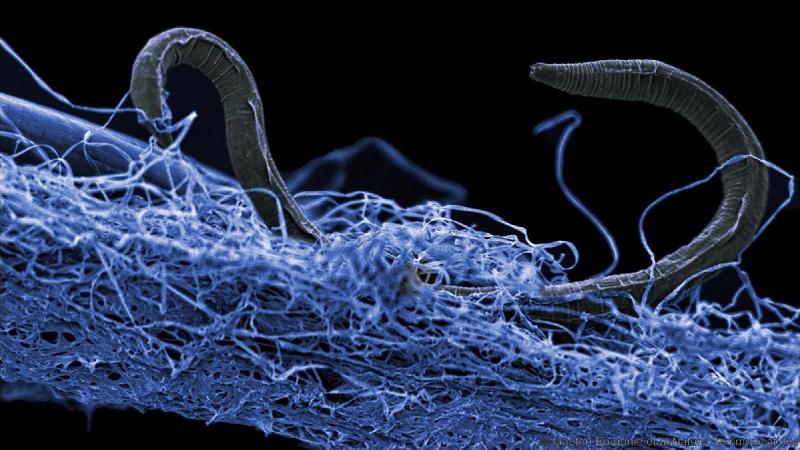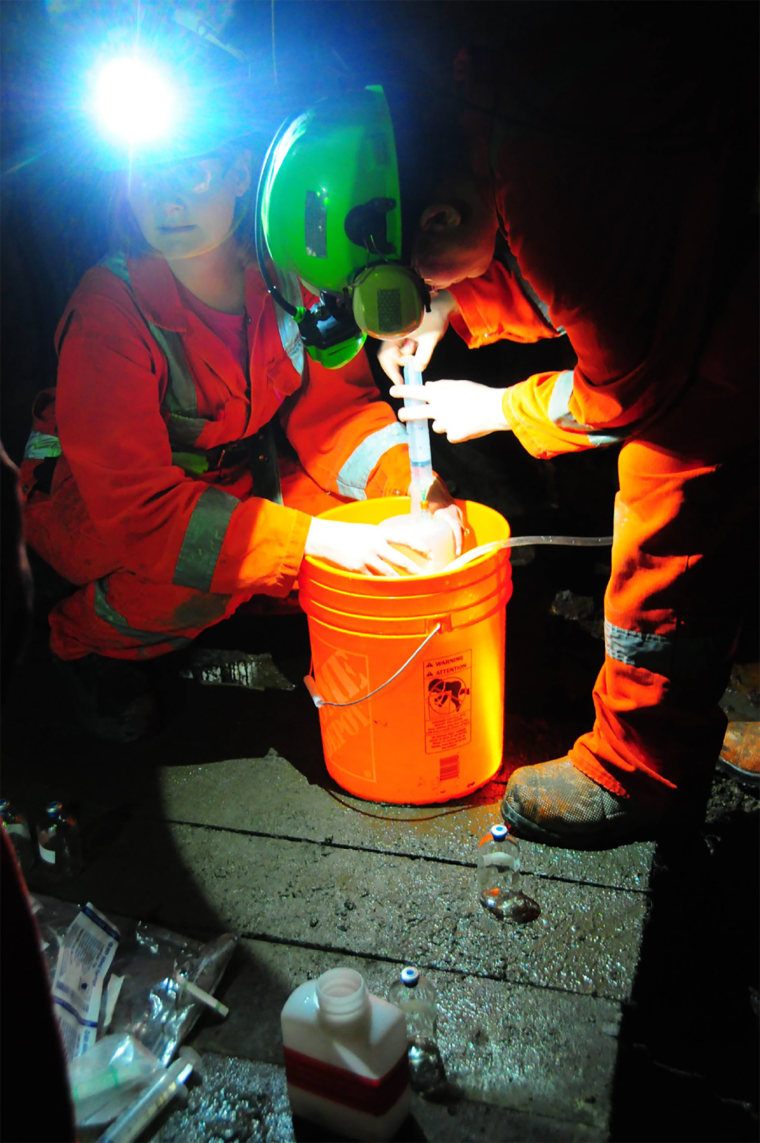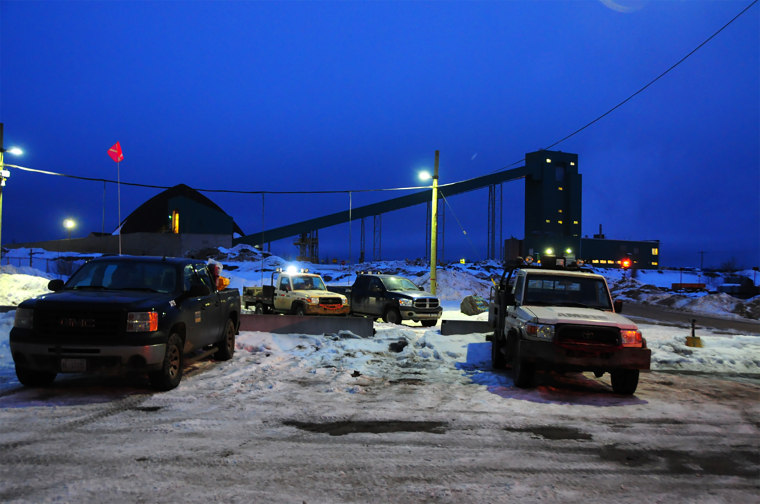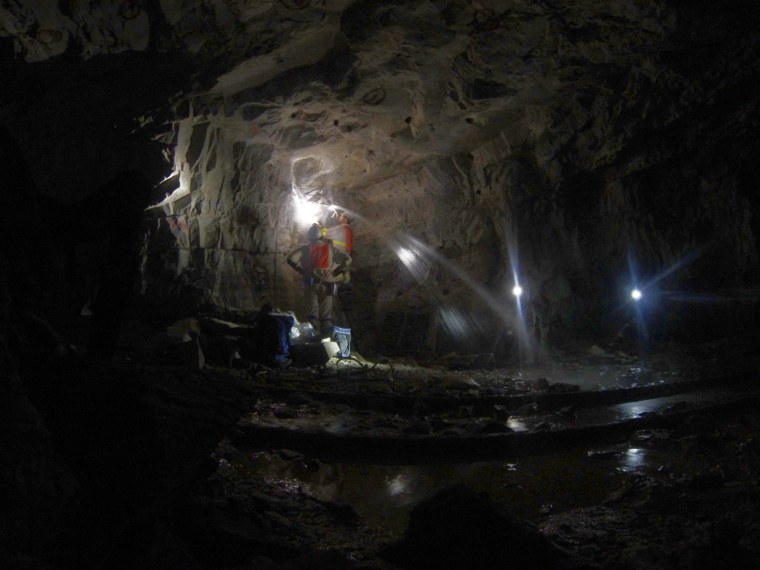Strange life-forms found deep in a mine point to vast 'underground Galapagos'



Something odd is stirring in the depths of Canada's Kidd Mine. The zinc and copper mine, 350 miles northwest of Toronto, is the deepest spot ever explored on land and the reservoir of the oldest known water. And yet 7,900 feet below the surface, in perpetual darkness and in waters that have remained undisturbed for up to two billion years, the mine is teeming with life.
Many scientists had doubted that anything could live under such extreme conditions. But in July, a team led by University of Toronto geologist Barbara Sherwood Lollar reported that the mine’s dark, deep water harbors a population of remarkable microbes .
The single-celled organisms don’t need oxygen because they breathe sulfur compounds. Nor do they need sunlight. Instead, they live off chemicals in the surrounding rock — in particular, the glittery mineral pyrite, commonly known as fool’s gold.
“It's a fascinating system where the organisms are literally eating fool's gold to survive,” Sherwood Lollar said. “What we are finding is so exciting — like ‘being a kid again’ level exciting.”

Barbara Sherwood Lollar's team at work in the mine. Stable Isotope Laboratory / University of Toronto
Sherwood Lollar is excited not only because of the peculiar the mine’s rock-eating life seems, but also because of the growing realization that strange forms of life might not be so peculiar after all. Scientists are starting to find similar microbes in other deep spots , including boreholes, volcanic vents on the bottom of the ocean and buried sediments far beneath the seafloor.
“The deep microbial realm reveals a biosphere that’s more extensive, resilient, varied and strange than we had realized,” said Robert Hazen, a mineralogist at the Carnegie Institution’s Geophysical Laboratory in Washington, and co-founder of Deep Carbon Observatory, a global project to study the deep biosphere .
Cut off from light, air, and any connection to the surface, this shadowy realm seems more like an alien world than part of Earth. Hazen said exploring it could help us understand how life might have begun on other planets as well as on our own. We might even find alien-like creatures living undetected right beneath our feet.
Lots of life at the bottom
Sherwood Lollar’s work builds on a 2018 report by Deep Carbon Observatory scientists who tried to map the total extent of Earth’s deep biosphere comprehensively for the first time.
In the eye-opening report, a team led by Cara Magnabosco, a geobiologist at the Swiss technical university ETH Zurich, estimated that some 5 x 10^29 cells live in the deep Earth : that’s five-hundred-thousand-trillion-trillion cells. Collectively, they weigh 300 times as much as all living people combined. The team describes this hidden ecosystem as an “underground Galapagos.”

An exterior shot of Kidd Mine. table Isotope Laboratory / University of Toronto
The denizens of the deep are an exotic bunch even beyond their appetite for solid rock. One species, the microbe Geogemma barossii , can live at temperatures of 250 degrees Fahrenheit — well above the boiling point of water and close to the theoretical limit at which vital organic molecules start to disintegrate.
Separate studies of material drilled near the Mariana Trench in the Pacific Ocean hint that some organisms could be living six miles below the seafloor , limited only by the heat at such tremendous depths. Laboratory experiments show that some microbes can tolerate pressures 20,000 times higher than the air pressure at sea level , meaning that there are almost certainly more extreme ecosystems out there than the one in the Kidd Mine.
“We’re finding that we don't really understand the limits to life,” Sherwood Lollar said.
The pace of existence in the deep also seems radically different from that on the surface. In ancient environments like the trapped waters at the bottom of the Kidd Mine, food and energy are scarce. To compensate, cellular metabolism slows almost to a standstill.
“Many of the microbes may survive for thousands of years or more without dividing, just replacing their broken parts,” said Karen Lloyd, a University of Tennessee microbiologist who studies life at the bottom of the ocean.
There are so many deep microbes that, despite a seemingly lazy existence, they collectively exert a huge impact on their habitats. For instance, a community of cells on the ocean floor consume methane gas that bubbles up from ancient sediment. “Deep subsurface microbes eat massive amounts of methane that would otherwise be released,” Lloyd said, helping curb atmospheric levels of a potent greenhouse gas.
Back to beginnings
One of the big questions facing Sherwood Lollar is how the deep-life community at the Kidd Mine is related to those found in other mines or stretched out beneath the oceans. “The number of systems we've looked at so far really is limited,” she said, “but they probably had a single origin at some point in life’s 4-billion-year history.”
If so, there should still be clues about when and how life first colonized the deep.
Fossils show that surface life has changed enormously over billions of years, but slow-motion deep life may retain much of its primitive characteristics. That’s especially true at the Kidd Mine, which is in one of the oldest, most stable portions of Earth’s crust. (The rock in and around the mine have lain undisturbed for 2.7 billion years, and have been cool enough to support life for at least 2 billion years.)

Cara Magnabosco and colleagues collect ancient water samples 4,300 feet deep within the Beatrix Gold Mine, South Africa to investigate the diversity and abundance of deep microbes. Image courtesy of Gaetan Borgonie (Extreme Life Isyensya, Belgium) and Barbara Sherwood Lollar. University of Toronto, Canada
Sherwood Lollar wants to sequence the genes of the Kidd Creek microbes and then do a 23andMe-style analysis to unravel their kinship to other residents of the deep Earth: Are they all still close relatives, or have they diversified and adapted significantly to their local environments? It’s a delicate project, but she hopes to have results within a year or two.
Such studies could offer hints about where life first arose on Earth. Charles Darwin imagined the beginning might have occurred in a warm little pond, but “there's absolutely no reason why it could not have been a warm little rock fracture,” Sherwood Lollar said. In many ways, she noted, sulfur-breathing microbes living beneath thick, protective layers of rock would have been well suited to the brutal conditions on our planet when it was young.
Another, even wilder possibility is that life originated more than once, with other forms still surviving somewhere on Earth. “We've literally only scratched the surface of the deep biosphere,” Hazen said. “Might there be entire domains that are not dependent on the DNA, RNA and protein basis of life as we know it?” Perhaps we just haven’t found them yet.
Paul Davies, a physicist at Arizona State University, has long advocated systematic searches for such “shadow life.” The recent forays into the deep biosphere show how it might be done. Since known organisms cannot survive above 250 degrees Fahrenheit, Davies suggests going to extreme environments (around undersea volcanic vents, for instance) and checking for anything that appears alive at temperatures around 300 to 400 degrees Fahrenheit.
"That would stand out as a candidate for shadow life,” he said.
Ever cautious, Sherwood Lollar points out that she hasn’t found any evidence of shadow life at the Kidd Mine. But she heartily agrees that scientists need to keep a wide-open mind about what could be lurking within the deep world: “We see only what we look for. If we don't look for something, we miss it.”


An unusual environment for life. Suggests that life might be more prevalent (and diverse) than we thought (and that is saying something).
I watched a documentary about this discovery in an african gold mine several months ago. the possibilities of life beyond earth are now even more infinite.
Also, I think there is more to life here on earth that has been here long before humans that has yet to be discovered, and has been slowly developing into even newer species.
Many are located in areas of the earth that humans have not as yet discovered, so each new find opens the door to types of life forms never seen before.
Mother Earth is a fascinating incubator of various life forms that await being discovered. Some of which may one day be Man's savior.
It is times such as this that science discovers that Mother Earth may be capable of supporting more diverse life forms than has ever been considered possible.
Indeed. She continues to surprise and inform.
I don't know if that's we can say anymore, basically my thought now is if there is an environment that can be exploited life will find a way to do so.
Indeed. This also increases the chance of life being elsewhere in the universe, maybe even our own solar system. Knowing the conditions in which life forms and thrives gives us a starting point to search for them, regardless of most environments.
Exactly. Back 40 some years ago when I was being brainwashed into believing there must be a God and that evolution was a lie, they often used what they thought was a fact, that life is a delicate thing, that only in this precarious balance of exactly the right conditions could life have formed and exist, therefore, God. But the more we find out about life the more it surprises us at how flexible and resilient it really is and can not only survive but thrive in some of the harshest environments on the planet.
DP, none of this story makes it clear that there is not a God - guiding Mind/s over all things. The mere inverse could easily be true: That something exist in the harshest of environments (known to man) gives rise to how many 'versions' of life there can possibly (impossibly?) be. What ineffable forces are at work in the planets, stars, and systems of Space.
I never said that this proves there isn't a God. I merely pointed out that the many attempts to use old understandings about life as proof of a creator were beyond wrong. The conclusions some draw and claim it as evidence to support their beliefs is flawed. If you want to believe in a God, go right ahead, I'm not trying to convince you otherwise. Just don't attempt to use logic and reason to do so until there is some actual logical, rational empirical evidence of a God to present. Until then, accept that it's just personal opinion and faith that resides in each individual believer. Every time a believer picks up a fact about the universe and says "This is it! This proves my faith!" they are inviting others to examine, critique and shoot down the supposed evidence, which sadly, some perceive as shooting down their faith and get upset. And besides, searching so desperately for some fact to support their faith merely exposes their weakness in faith, hoping beyond hope for a shred of physical evidence to defeat the doubts that already exists within them which is why I believe they get so defensive.
If they've adapted to use sulfur in the place of oxygen, I imagine the genetic differences are likely pretty significant.
And, there are other planets within our system and this galaxy that don't have oxygen. What is to say that there aren't other lifeforms throughout our galaxy/universe and they just don't "fit within our boxes" to described as "Living"????
I think it's likely there are.
We have had to refine our definition of "life", and there are still things that don't fit neatly in our boxes. Viruses, for example - they reproduce and evolve, but they don't metabolize.
It made me think immediately of ocean floor thermal vents and the crabs, shrimp, corals and tube worms that thrive there along with microbes in a 400 degree chemical bath, but even after these discoveries, there are people who insist that basic cell structure indicates a beginning in something other than salt water.
This is an interesting read, that is more of a paralell topic rather than being off topic.
pretty sure nobody here cares. don't worry.
i flagged it immediately
The FIRST thing that came to my feeble mind while attempting to digest this like a Sulfur snack pack eating away at my rock hard cranium, was
i wonder how many species of other strange life forms have we extincted, especially with that little ole oil and gas extraction method known as Fracking.
Wasn't Fracking, where they used a mixture of chemicals in a liquid solution, and pumped it into the ground, yet they wouldn't reveal exactly what was in this liquid solution used to displace the fuels ?
I'm pretty sure, this is not the best way to meet new life forms, but i'm guessing, if i've got it wrong, this is a seed where it might be properly explained, just like in a badfish seed.
thank you
Another fascinating topic.
My question is, and very well could be answered by the dna analysis, did these microbes adapt to the sulphurous environment or did they become in the sulphurous environment?
The answer to that question has the potential to present many more doors worth opening.
I wonder if under the right conditions, if these life forms could evolve past being single celled. Now that would be a game changer.
Yes, that. Emphatically.
Pardon me for getting off topic, but this article reminded me of another I saw in the news about a new hominid skull found which changes scientific understanding of human evolution and it's timeline. I'll have to if I can find it and post it.
Just because O2 and water is essential to sustain life here, I believe there may be other planets whose occupants do not have the same needs. Just as our periodic table contains what we know, I am betting there are other metals out there that we have no idea what they consist of. What makes us possible may not be what makes life elsewhere possible.
Great!!!
Now I'll have to move out of my cave, I'm just not comfortable in there any more...
Maybe I can find a nice haunted house or something.